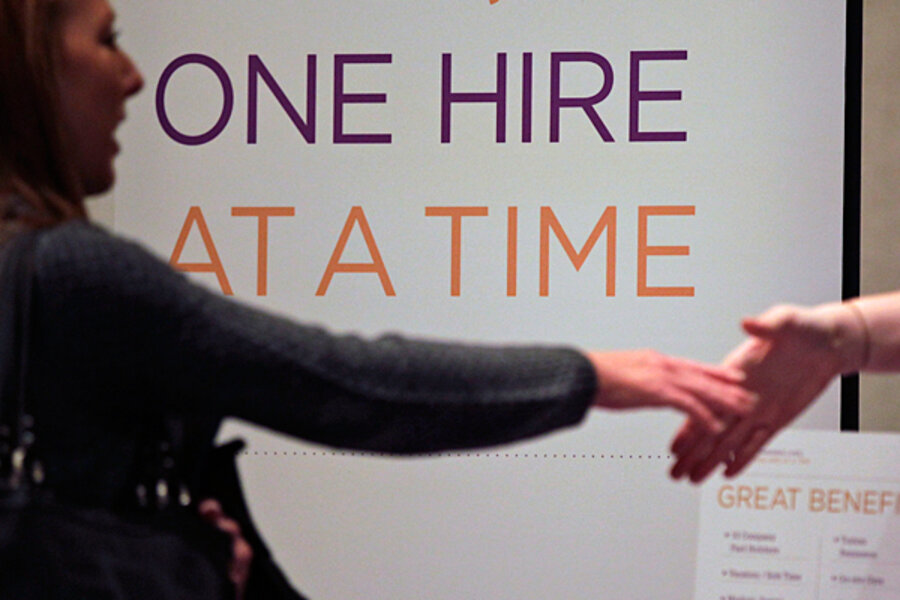Unemployment rate drops to 9.4 percent, but little cheer in jobless report
Loading...
| New York
The US economy finished 2010 with only lukewarm job gains.
Employment in the month of December increased by 103,000 jobs, the US Department of Labor reported Friday. That figure is considerably less than most economists had anticipated. At the same time, the unemployment rate fell from 9.8 percent to 9.4 percent – its lowest level since May 2009, which partially reflects fewer people actively looking for work.
The moderate gain in jobs underscores the difficulty of replacing jobs once they are lost. From the start of the recession in December 2007 to its end in June 2009, the US economy lost between 6 million and 8 million jobs. In 2010, according to the Bureau of Labor Statistics, the economy gained only 700,000 jobs back after not adding any jobs in 2009.
“This is not like the 1960s and 1970s, when there were temporary layoffs and the workers were called back,” says John Silvia, chief economist at Wells Fargo Securities in Charlotte, N.C. “These are not temporary layoffs. We have permanent layoffs, and that makes the job situation far more difficult.”
For those who are out of work, it may take far longer than expected to find a job, indicated Federal Reserve Chairman Ben Bernanke, who testified before Congress on Friday. “It could take four or five years for the job market to normalize fully,” he told the Senate Budget Committee.
Republicans immediately used the disappointing numbers as a way to attack President Obama’s health-care reform law. On Friday, they started a process to try to repeal it.
“Today, we will take the first steps towards repealing the job-killing health care law, so we can replace it with reforms that will lower costs and protect jobs,” said Speaker John Boehner (R) of Ohio in a statement.
The White House viewed the data more optimistically.
“The overall trend of economic data over the past several months has been encouraging, due in large part to the initiatives passed by this Administration, but we still have a ways to go,” said Austan Goolsbee, chairman of the Council of Economic Advisers.
In Landover, Md., Mr. Obama, speaking at a manufacturing plant, said, “We know these numbers can bounce around month to month, but the trend is clear: We saw 12 straight months of private-sector job growth. That's the first time that's been true since 2006.”
Despite the statements, economists do not expect much to happen from Washington that will affect the jobs picture.
“The federal response to the economy is done. It’s over,” says Richard DeKaser, an economist at the Parthenon Group, a management consulting business based in Boston. “The stimulus legislation that passed a month ago in the lame-duck Congress is all we are going to get.”
The slower-than-expected job growth, however, may result in the Federal Reserve beginning a third round of monetary easing, Mr. Silvia says. “They may not announce it,” he says. “But they will want to keep mortgage rates down.
Mortgage rates have been rising and are now at 4.85 percent for a 30-year fixed-rate mortgage.
Economists had hoped December would show a more robust labor market. On Wednesday, ADP, a payroll processing firm, released its monthly survey that indicated private employment rose 297,000 after a 92,000 rise in November.
Also on Wednesday, Challenger, Gray & Christmas, a Chicago-based outplacement firm, said that announced job cuts in December fell to their lowest monthly level since 2000.
Both reports led many economists to predict much stronger job gains than actually occurred. Estimates before the Labor Department report ranged as high as a net gain of 300,000 jobs.
Economist Bob Brusca of Fact & Opinion Economics in New York, who had predicted a gain of 300,000, says the confusion is because ADP and the Labor Department do different surveys, have different cutoff dates, and use different methodologies.
“When the economy is shifting gears it is not surprising that slightly different approaches will produce different results,” he writes in an analysis. “The results are different but ALL ARE POSITIVE.”
Despite the modest December report, there are still signs the economy is moving closer to a higher level of employment, some economists say.
For example, there is still pent-up demand for vehicles, Mr. DeKaser says. This was reflected in a gain of about 10,000 jobs in December compared with November.
At the same time, he notes, corporations are hoarding huge amounts of cash. Instead of investing the money in new factories, he says, “CEOs are fearful the new investments will result in unacceptable risks.”
Even though the unemployment rate fell in December, Silvia says that was partly the result of people “disappearing into the woodwork” – that is, unemployed people dropping out of the labor force because they don’t think work is available. (This means they aren’t counted in the unemployment rate.) According to the Bureau of Labor Statistics, 2010 saw an increase of 389,000 discouraged workers. In December alone, some 260,000 people left the labor force, according to the bureau.
“Again, we need to focus more on retraining,” Silvia says. “People need to move where the jobs are.”
Job growth in December mainly came from leisure and hospitality (up 47,000) and health care (up 36,000).





